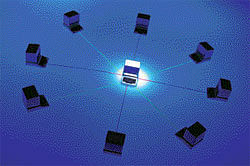Intel spreads its university research bets

Look at the engines behind cloud computing — vast, distributed armies of server computers. Even at the chip level, the wave of the recent past and the future is, as they say in the industry, multicore — microprocessors with multiple data-processing cores, for lower-power consumption and better performance.
So Intel, the chip giant, has decided to take a more distributed approach to financing university research. The company said this week that it would pour $100 million over the next five years into projects at universities. Each of the projects will involve a few Intel researchers, typically four, with far-flung teams of researchers from several universities.
Some of the money will be additional financing, but Intel is also shutting down its previous company-university collaborations. These were small labs set up in partnership with three institutions — Carnegie Mellon University, the University of Washington and the University of California, Berkeley. They were called “lablets,” and they were stand-alone facilities.
The new approach, Justin Rattner, Intel’s chief technology officer, explained in an interview “allows us to include more institutions, get broader coverage and get more money to university researchers.”
Much of the financing for the lablets, he said, went to pay for the lab operations themselves.
The first of the new projects, Intel Science and Technology Centers, will be based at Stanford. It will be financed at $2.5 million a year for five years, and focus on research in visual computing. Thirty faculty members and 50 graduate students from eight universities will collaborate. The other universities are Harvard, Cornell, Princeton, the University of Washington and three institutions in the University of California system — Davis, Berkeley and Irvine.
“What we really want to do is create an entire community of researchers focusing on an area of research,”Rattner said.
Visual computing is a broad field, to be sure. But Rattner said targets of research would include improving the user experience on devices like Internet-connected televisions, digital tablets and even digital signs.
New user interfaces and tools, he said, were likely subjects. In particular, Rattner said he would like to see better tools for non-professional users to create 3-D content. “It’s amazing what people have built in Second Life, given how primitive the tools are,” he said.
In the future, Rattner said, he would like to see tools both powerful and easy enough to use so that a 10-year-old could build his or her own 3-D game. In retailing, he said, improved 3-D imagery and tools could “really transform the fashion industry.” Someday, he added, “We’ll all have our own anatomically correct avatars and clothe them.”
You look at how a garment really would look on you — front, back, moving around — then you push a button to order it and have it made. That, he said, will drastically change the sales, design and manufacturing of clothing. “That is coming,” Rattner predicted.
The project is the first of perhaps six to eight similar efforts. Others, Ratter said, could focus on fields like cloud computing, secure computing and perceptual computing — “devices that can recognise and move about the world in intelligent ways,” he explained.
Most major technology companies finance collaborative research with universities. But Intel’s distributed approach seems to stand out.
“This assembling of multi-university dream teams to work on big computer science problems is unusual for industry,” said Edward Lazowska, a professor at the University of Washington. “But the government’s National Science Foundation certainly does it.”
Deccan Herald is on WhatsApp Channels| Join now for Breaking News & Editor's Picks